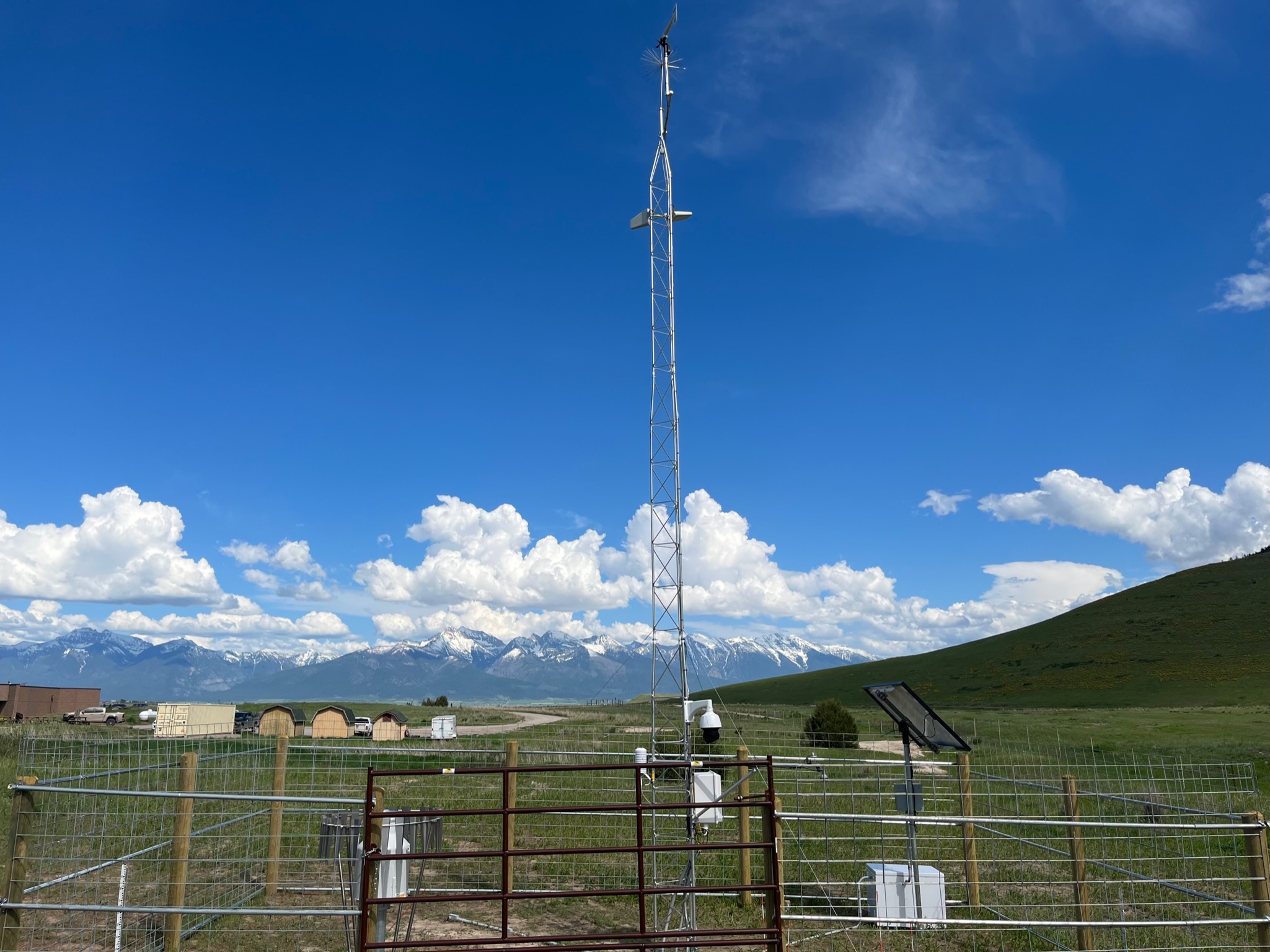On April 26, 2023, the Montana Climate Office in collaboration with the Confederated Salish and Kootenai tribes installed a new Mesonet station on the CSKT Bison Range, greatly expanding soil moisture and meteorological monitoring capabilities on the Flathead reservation. The new station — funded by the Native Drought Resilience project through a grant by NOAA’s National Integrated Drought Information System (NIDIS) — will contribute to research efforts and public outreach at this unique ecosystem, providing essential data to Native communities for land management and climate change adaptation. Read on for more information about the Mesonet and the exciting possibilities of this new station.
The Montana Mesonet
According to the University of Montana Climate Office, the Mesonet is a “cooperative statewide soil moisture and meteorological information system”, comprising over 100 monitoring stations which collect data continuously. The data produced by the Mesonet helps land managers make informed decisions about water use and vegetation cover on the rangelands, forests, and agricultural lands which they oversee. All data is free and publicly available in real time on the Montana Mesonet Data Dashboard. This accessibility is an essential part of the program, allowing anyone from small agribusinesses to tribal governments to federal land managers to benefit from highly accurate data. All stations are solar-powered, allowing for a sustainable system suited to remote locations. With approximately 62 percent of land in Montana used for agriculture and a rapidly changing and increasingly unpredictable climate, understanding local variations in climate is absolutely essential.

The Mesonet station at the CSKT Bison Range

Viewing the Mesonet Site
Monitoring Conditions on the Bison Range
The Mesonet is currently in the process of installing 205 more stations across the state of Montana as part of a 2020 contract with the US Army Corps. This station at the CSKT Bison Range is especially important for multiple reasons. Firstly, it is located in an area with little other monitoring capacity. This is a problem for many tribal lands, and the lack of relevant data can hinder effective land management and agricultural development. Expanding monitoring capacity will benefit land managers working with the Confederated Salish and Kootenai Tribes as well as provide new climate-focused educational and research opportunities on the Reservation.
Secondly, the CSKT Bison Range is a tremendously important ecosystem home to many ecologically and culturally important species. Traditional plants such as blue camas and bitterroot flourish alongside hundreds of native bird species, large mammals, and aquatic species including bull trout. The bison herd is one of the only herds of genetically pure plains bison in the world; all existing bison without cattle genes have been bred from the herd on the Flathead Reservation. The herd was established in the 1870s by tribal members Michael Pablo and Charles Allard and remains an important part of cultural heritage and first food networks on the Reservation. Effective monitoring and management are essential to conserving this unique ecosystem for future generations.
New Data, New Possibilities
Under the management of the Confederated Salish and Kootenai Tribes, the Bison Range has welcomed a wide range of research initiatives. New data from the Mesonet station will strengthen existing research and open new avenues for investigation. A better understanding of soil moisture on the Bison Range, for example, will help ensure the success of future revegetation projects and assist ecologists in deciding which plants will be most resilient to future conditions. Although SSURGO soil data exists for this area, the ground here still holds many secrets. During the installation of the Mesonet station researchers discovered a clay lens deep in the soil which has a very high water retention capacity, but may prevent the root systems of native bunchgrass from reaching further into the soil. Variations like this one are little understood as of yet on the CSKT Bison Range, and researchers hope the Mesonet station alongside more scientific investigation and monitoring efforts will illuminate soil conditions and their ecosystem impacts. Besides soil moisture, long-term monitoring of meteorological data will contribute to in-depth understanding of climate change impacts on this region, planning, and mitigation actions. This is a priority for the CSKT, as outlined by their Climate Change Strategic Plan.
The new Mesonet station and its data will also be a valuable outreach tool to educate the public about local climate variability and its effects on ecosystems. The Bison Range is a destination for school groups, tourists, and student researchers from Salish Kootenai College, all of whom will now have an opportunity to learn about the Mesonet through planned interpretative signage. The public-facing nature of this station makes it all the more important.
The installation of the Mesonet station is an important step for both the Montana Climate office and the Confederated Salish and Kootenai tribes in developing tools for land managers and preparing for a sustainable climate future. It provides exciting new data and outreach opportunities on one of Montana’s most culturally and ecologically significant landscapes. Start exploring the latest climate and soil data by clicking on the button, or exploring the page below:
